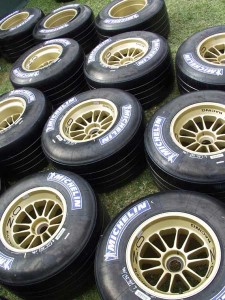It’s not very often you can improve the comfort, performance, safety and fuel economy of your automobile in one simple step. Yet all it takes is making sure your tires are properly inflated.
Tires are the most under-rated part of your car, truck or crossover, and studies show they’re also, typically, underinflated. Yet a tire that’s low on pressure is likely to impact almost every impact of the way your car behaves – which is why motorists might use National Tire Month as reason to make sure those black donuts are both properly inflated and in good shape.
A tire that’s low on pressure not likely to deliver the comfort designed into your car. But it is likely to wear out faster – and even increase the risk of a blow-out. It can be slower to accelerate and take longer to stop.
Then there’s fuel economy. On average, a tire consumes about 20% of the energy used to move your vehicle forward. Improperly inflated, they can reduce your fuel economy by 10% or more. The Department of Transportation estimates that 5 million gallons of fuel are wasted every day due to under-inflated tires. For the average motorist that can translate into an extra $150 or more in extra fuel costs each year.
Tire pressure isn’t the only thing to keep in mind, of course. For all the high-tech hardware built into your car, truck or crossover, that rubber is the only thing in contact with the road. As big as they might appear, each tires contact patch is barely bigger than your hand. So worn tires also have a big impact on performance and handling, and increase your risk of an accident.
Here are some basic tire tips:
- Check the inflation of all four tires at least once a month. And make sure to do so when the tire is cool. Friction from driving causes heat and that can cause an inaccurate reading;
- Don’t trust your eyes. By the time a tire looks low it’s already severely under-inflated;
- Check the owner’s manual for the right inflation – the number may also be on a sticker in the driver’s door jam or inside the glovebox. Do NOT use the maximum pressure number molded into he tire’s sidewall;
- Rotate your tires regularly to balance out wear. They’ll last longer and perform better. But check the manual to see the proper rotation pattern, as it can vary from vehicle to vehicle. Include a full-sized spare – but not a mini-spare – in the rotation;
- And check to make sure your tires aren’t worn out. It’s easy to do: just place a penny into the shallowest groove with Abraham Lincoln’s head pointed down. If you can see the top of his head, it’s time to replace the tire.
Speaking of spares, we frequently see motorists driving around on those mini-wheels that many manufacturers have switched to in order to save space and weight. These are not designed to be full-time alternatives to a regular tire. They’re there for temporary use only, and should be driven at relatively low speeds, usually no more than 60 to 65 mph, and minimal distances. If you need one, get your regular tire fixed or replaced as soon as possible.
The average car on the road today is equipped with all-season tires. They’re great for most of the year, but if you live in the Snowbelt consider getting one of the new winter tires, such as the Bridgestone Blizzak. These tires are specially designed to maximize contact with slick surfaces and can cut stopping distances on wet pavement by as much as a car length or more at highway speeds.
If you’re trying to maximim mileage, meanwhile, consder something like the Michelin Primacy, which is designed to improve fuel economy by reducing rolling resistance.
Whatever your needs, it helps to learn about the various tire rating systems that help you compare both maximum speed and fuel efficiency.
And take another simple step to register your tire with the new national registry that’s been created to ensure you’re notified in the event of a tire recall. The good news is that manufacturers automatically enroll your tires when you buy a new car, and a reputable dealer will be the same thing when you buy replacement rubber.
In a nation that celebrates everything from broccoli to clogging, it’s easy to ignore National Tire Month. But the fact is that your tires are worth a little of your time and attention. A few simple maintenance tips can keep you safe and comfortable – and save you money.

